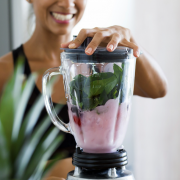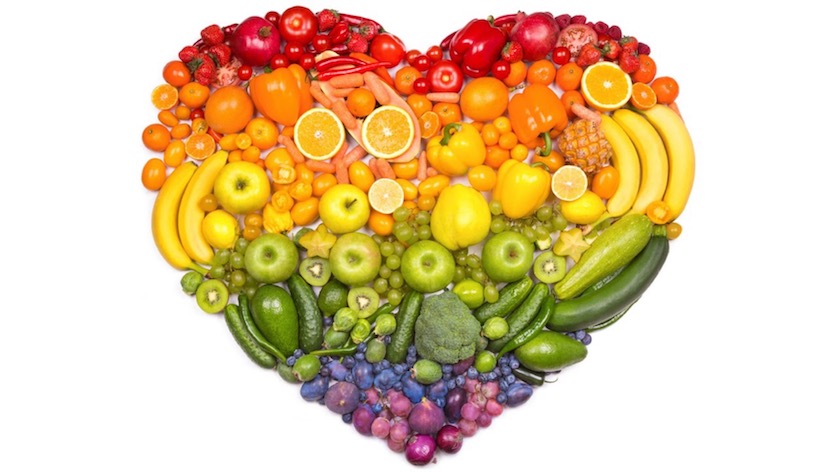A while back I met with a longtime client who was extremely excited about her new hobby, making “healthy” smoothies. For the sake of privacy, I’ll call her Karen. Over the course of my consulting with Karen, she’d successfully lost weight and lowered both her blood pressure and cholesterol levels—so much so that she was able to reduce her use of medications. This is fantastic considering that Karen was well in her 70s.
Filled with excitement about her new approach to healthy eating I immediately asked Karen about some of the smoothies she made. With a huge smile on her face, Karen explained how every morning she made a smoothie comprised of 1-2 bananas and “handfuls” of blueberries and grapes, canned peaches, and celery. She sometimes included orange juice as well, which she referred to as “the good kind in a carton that tastes real sweet.”
Karen also told me she started drinking these smoothies about five months prior and boasted about how energized she felt.
After hearing about the ingredients in her smoothies I immediately asked Karen when was the last time she got her blood sugar levels checked. She hesitated and mentioned that it was about a month ago and said “they were kind of high”—so, high that she had an upcoming follow up appointment with her physician.
Now, based on what you’ve read so far, do you think there’s anything wrong with Karen’s fruit-dense smoothies? Do you have any idea as to why her blood sugar levels were high? If your answer to either of these questions is “no” I urge you to read on.
What’s the problem with drinking fruit-dense smoothies?
Fruit consumption in general is a controversial topic these days. Most of us have been told all our lives that fruits are good for us yet some experts, including myself, recommend limiting daily intake. Though fruits are remarkably high in nutritional value and necessary for good health, many house very large quantities of sugar in the form of fructose (fruit sugar).
This isn’t necessarily a good thing, especially if you’re regularly physically inactive, as unused sugar can build up in the bloodstream and eventually set off a chain of adverse health effects.
Like Karen, many people prefer the sweet taste of fruit-rich smoothies. But, when it comes to drinking smoothies, you have to be extremely careful, as the sugar they contain tends to digest and absorb much faster since they’re consumed in liquid form. As such, drinking fruit-heavy smoothies will cause sharper rises in your blood sugar (glucose) levels than eating them.
Drinking fruit-heavy smoothies will cause sharper rises in your blood sugar (glucose) levels than eating them.
Excess blood glucose triggers insulin surges from the pancreas, which prompt the body’s cells to store it in the liver for later use. However, since the liver can only hold glucose in very small amounts, any excess that’s not utilized by the body (usually due to inactivity) is converted into fat and stored as adipose tissue, primarily in the belly area.
Interestingly, Karen told me she noticed a significant increase in the size of her waistline since we’d last met.
Over time, continuous surges of insulin can cause the body’s cells to become less sensitive to it (insulin resistance), which greatly contributes to the development of type 2 diabetes. It is this factor that explains just why Karen’s blood sugar levels were elevated, a state that’s referred to hyperglycemia.
Related Article: How Healthy Eating Habits Can Ward Off Type 2 Diabetes
Can you drink smoothies if you have hyperglycemia or diabetes?
There’s absolutely no reason why fruit smoothies and smoothies in general can’t be included in a well-balanced diet. However, if you have diabetes, hyperglycemia or are just trying to lower your risk, there are certain nutritional strategies you should follow to ensure your smoothies aren’t exceptionally high in sugar. Here are five of them.
1. Avoid using large amounts of fruit, plain and simple.
If you regularly drink smoothies prepared with 2-3 bananas and handfuls of other fruits you have to change it up. On the average, you should consume 2-4 servings of fruit per day. As such, it’s best not to include more than 1-2 servings in a single smoothie. Given that 1/2 of a medium-sized banana constitutes one serving of fruit, two bananas represent four servings.
Add more fruit and you’re well over the recommended daily serving. Moreover, two bananas can house in excess of 220 calories and over 40 grams of sugar, which is equivalent to a canned soft drink. When making smoothies, it’s a good rule of thumb to incorporate sensible portions of fruits that are naturally lower in sugar like berries.
2. Use plenty of leafy green vegetables.
Smoothies are actually a great way to sneak more veggies into your diet, so be sure to include them in sizable quantities in order to minimize the calories and sugar while maximizing the nutritional quality. Leafy green vegetables like kale and spinach work great in smoothies as they’re virtually tasteless.
Moreover, leafy greens are essentially sugar-free and house incredibly large amounts of fiber, vitamin C, vitamin K, potassium, and calcium. They are also rich in potent antioxidants like carotenoids and indoles, which have been shown to protect against heart disease, cancer and countless other chronic conditions.
3. Use strained yogurt or milk as a base.
Strained yogurt and milk are both high in protein. Regularly consuming such protein-rich foods can help you keep your blood sugar levels under control. These foods also trigger a sense of fullness, which reduces the urge to overeat. This is especially important because most individuals with type 2 diabetes are either overweight or obese.
But, it doesn’t stop there. These foods are also high in vitamin B12 and calcium, which are critical for adequate energy levels, bone health, and proper functioning of nerves, muscles, and blood vessels.
4. Incorporate foods rich in healthy fats.
Healthy fats (monounsaturated fat and omega-3 fatty acids) can greatly stabilize blood sugar levels. These fats are housed in a variety of foods that can effortlessly be included in almost any smoothie. Simply add a serving of avocado, nuts, flaxseeds or chia seeds to your blends.
You can also use 1-2 tablespoons of minimally processed unsweetened nut butter (peanut, walnut or almond butter) to make your smoothies smoother and thicker. Although these fats are considered “healthy” moderation is key, as they tend to be very high in calories.
5. Experiment with 100% whole grain foods.
You can substantially boost the benefits of your smoothies by adding quinoa, rolled oats or other healthy whole grains. Whole grains are less likely to cause unhealthy spikes in blood sugar after consumption. In addition, these foods are high in dietary fiber making them perfect for increasing the filling effect of your smoothies.
Dietary fiber inhibits sudden spikes in blood glucose and insulin levels by slowing the digestion and absorption of glucose from the small intestine. Due to these effects, regularly consuming fiber greatly helps in both the prevention and management of diabetes and other conditions including heart disease, high blood pressure, and colorectal cancers.
When prepared the right way, smoothies can generally supply individuals with hyperglycemia or diabetes with healthy doses of good carbohydrates and other high-quality nutrients.
So, what’s the key take away?
There are many people like Karen who have unknowingly sabotaged their efforts to eat healthy due to a serious misunderstanding of how simple substances like sugar can impact the body, even in natural form. While you might think the sugar in fruits is meaningless, it’s important to understand that sugar is hidden in many types of foods including potatoes, breads and even milk.
In light of these facts, it’s important to always be mindful of your daily intake from fruits as well as other sugar-containing foods.
When prepared the right way, smoothies can generally supply individuals with hyperglycemia or diabetes with healthy doses of good carbohydrates and other high-quality nutrients. By considering the information I’ve presented and following the strategies I’ve outlined, you can greatly increase the overall nutritional value of your smoothies without sending your blood sugar levels spiraling out of control.
Related Article: 5 Simple and Delicious Low-Sugar Smoothie Recipes for People with Diabetes







